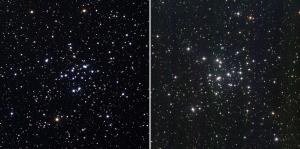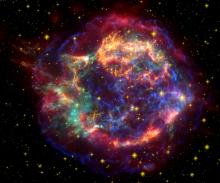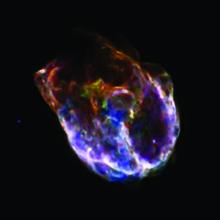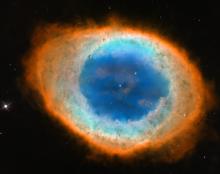The young star clusters Messier 34 (left) and Messier 36 sparkle in these ground-based images. Using different techniques for the two clusters, astronomers have determined that M34 is about 225 million years old, while M36 is less than 25 million years old. [REU Program/NOAO/AURA/NSF]
You are here
Counting Candles
There are many ways to count the candles on a star’s birthday cake. Two star clusters that are in the western evening sky at this time of year provide two examples.
Messier 34 is in the constellation Perseus. It’s about half way up the sky in the west-northwest at nightfall — well to the upper right of Venus, the “evening star.” And Messier 36 is higher in the sky, in Auriga. It’s to the left of the yellow-orange star Capella.
M36 is the younger of the two clusters — less than 25 million years old. One way astronomers came up with that number is by measuring lithium in especially small, cool stars.
Stars begin life with just a smattering of lithium. And it’s quickly destroyed by the star’s nuclear reactions. More-massive stars “burn” through their lithium faster than less-massive stars. So by measuring the amount of the element in stars of different weights, they can come up with an estimate of a cluster’s age — in this case, about 22 million years.
Astronomers used stars at the opposite end of the age scale to measure the age of M34. They used white dwarfs — the small, dead cores of once-normal stars. Stars of different masses burn out at different times, with heavier stars going first. And they leave white dwarfs that have different mixtures of chemical elements. The white dwarfs in M34 indicate an age of about 225 million years — a good match to the other techniques used to count a star’s birthday candles.
Script by Damond Benningfield
Get Premium Audio
Listen to today's episode of StarDate on the web the same day it airs in high-quality streaming audio without any extra ads or announcements. Choose a $8 one-month pass, or listen every day for a year for just $30.







